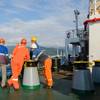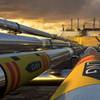By Larry Pearson
It is no secret that the overwhelming number of marine repair jobs at the nation's shipyards involves regulatory inspections.
For example, the 150-ft. supply boat Mary R. Martin was in at Allied Shipyard, Larose, La. in mid-July for ABS and Coast Guard inspection and the change out of a few seals. The boat was dry docked for the inspections and minor repair work, her hull blasted and painted and after a few topside repairs in the slip and more paint work she was back at work.
That type of "shave and a haircut" work is typical at Allied and other repair yards, but they are capable of much more complex work that literally extends the life of a vessel by many years. Earlier this year Allied finished a complete work over of the 195-ft. by 40-ft. supply boat Ms. Whitney owned by MNM Boat Service, Inc., Golden Meadow, La.
Ms. Whitney
The Ms. Whitney was built about 25 years ago and has served almost continuously in the Gulf of Mexico. The 195-ft. by 40-ft. supply boat was brought to Allied Shipyard in January 2003 and for the next three months the boat was completely reconditioned.
The Ms. Whitney was dry docked on January 7, 2003 and relaunched in mid-February.
"One of the first jobs we tackled was replacing the engines. The vessel was built with Caterpillar 399 engines and they served the vessel very well for 25 years," said Norris Galliano, project supervisor for MNM Boats.
The 399's were replaced by new Caterpillar 3512 diesels. "We were able to reuse the same gears with a little modification," Galliano said. The engine mounts required significant modifications as well as the exhaust and fuel piping "New piping also had to added to connect the engines to the existing channel coolers," Galliano said.
The shafts were reconditioned by Allied and the props reworked by Johnny's Propeller Shop in Morgan City, La.. The bow thruster propeller received the same careful inspection and rework as the main props.
The Detroit Diesel 6-71's driving 99 kW generators were in much better shape, requiring some cleaning and reworking of the generator ends only.
The same was basically true for the Detroit Diesel 8-71 driving the bow thruster and the 4-71 that powered the liquid mud pump and the bulk mud compressor.
One of the major projects in this modernization was replacement of hull plating as well as steel replacement throughout the boat. "We had to repair several ballast tanks, mud tanks, fuel tanks, potable water tanks, almost every tank on the boat was cleaned, repainted as needed and replaced steel where necessary," Galliano recalled. The rub rails were also replaced with 12-in. split pipe.
Considerable new steel was fabricated for the forepeak tank including its drain piping, internal angles, gussets, deep frames and the watertight bulkhead. The forward port and starboard passageway bulkheads needed considerable steel replacement, as did the port and starboard P-tank voids. One of the bulk mud tanks was removed from the vessel, reconditioned and reinstalled.
One of the rudders had to be completely rebuilt while the other needed to be straightened and a new bushing installed.
"Our usual routine is to send our pumps out to be reconditioned," Galliano said. The liquid mud pump had to be relocated. The ship's valves were opened and the seats, gates and bonnets cleaned. "Our routine on the valves is a little different as they have to be held open for inspection by Coast Guard and/or ABS inspectors before they can be reassembled," Galliano said.
The deck boards were retained although the retaining angles were blasted and painted. Angels and flat bars were welded into place to secure the deck boards.
Accommodations spaces and the galley needed only minor repairs included some replacement steel in the head and galley spaces.
The pilothouse was mainly retained as is except a new engine and fire monitor system was added.
The vessel was water blasted, primed and painted with International paint supplied by the customer. The vessel was completed on March 13, 2003.
Elsa Leigh
The second vessel featured is a 1983-vintage supply boat built at Moss Point Marine. The 254-ft. long Elsa Leigh worked for many years in a variety of capacities and was bought by now owner Aries Marine in late 2002. Immediately the vessel sailed to Bollinger Marine Fabricators in Morgan City, La. for a front to back overhaul. The main EMD engines were removed and sent to NREC, Houma La. for an overhaul. The engines went into NREC developing 1,250 hp and were returned rated at 1,500 hp. With higher power engines the gears were replaced with reconditioned Falk equipment.
The gensets were in better shape and the Detroit Diesel 12V71's needed only minor reconditioning. The vessel did need some new engines. A Cummins KT-19M3 replaced a Detroit Diesel engine to power the bow thruster. The Detroit Diesel engine was reconditioned and used to drive a fire pump connected to a pair of Stang 1,100 gpm fire monitors.
A stern thruster was added powered by a Cummins KT-19M4 engine. Two Cummins 6CT series engines were installed to drive new mud pumps and the Quincy air compressors that were a part of the dry bulk delivery system.
An interesting series of events led to the new dry bulk tanks now in the boat. "The original tanks were removed in the mid-1990's," said Bill Purvis, Aries Marine project manager. "The former owner of the boat, Seacor Marine, built four tanks intending to install them in the vessel," Purvis added. "Seacor never installed the tanks and we bought them with the boat," Purvis added.
Now the vessel can carry 6,000 cu. ft. of dry bulk. The liquid mud system was also reengineered by converting some ballast tanks to liquid mud, upping the holding capacity to 4,100 barrels
Numerous other tanks, pumps and the deck boards were changed. So too was over 20% of the steel changed. Johnny's Propeller Shop, Morgan City, La., reconditioned props and Bollinger's own machine shop reworked the shafts.
Engine Monitor Inc., St. Rose, La., supplied a completely integrated, American-made electronics package "It was important to us that as many components as possible in the electronics package and other systems on the boat be made in Louisiana," Purvis added.
"It is important to note that EMI does more than package existing electronic components," said Jack Rowley, EMI general manager. "The components are also manufactured, assembled and tested in our facility," Rowley noted.
The new electronics included a DP-1 system, 96-point alarm system, vessel steering system, engine control packages and controls for the bulk and liquid mud systems and controllers for the bow and stern thrusters.
The vessel went back to work in July 2003 in the Gulf of Mexico with many years of useful life remaining.
Sponsored Content
Innovative Hull Maintenance: Profitable & Green

December 2024
 Read the Magazine
Read the Magazine

 Read the Magazine
Read the Magazine
This issue sponsored by:

Propulsion Choices begin with Fuel and End with Politics
Subscribe for
Maritime Reporter E-News
Maritime Reporter E-News is the maritime industry's largest circulation and most authoritative ENews Service, delivered to your Email five times per week











